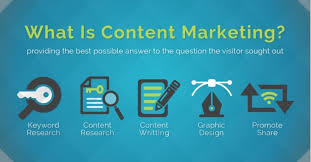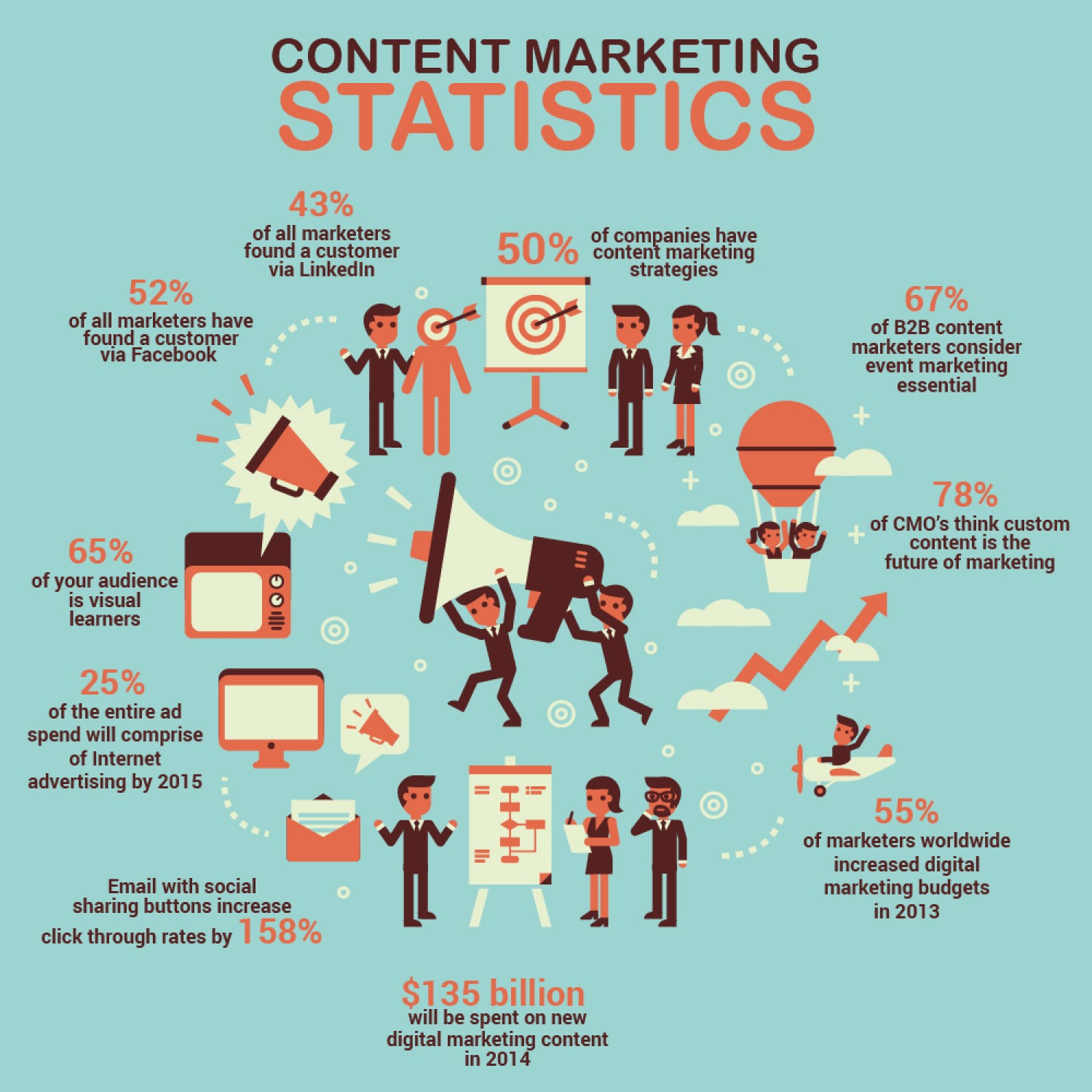Hello!
If you have a blog, we are sure you didn’t create it for yourself... The goal, of course, is to have your articles read, if possible by the greatest number of people. We will see that blogging is not so complicated, it is still relatively simple. The hard part is actually to be consistent and providing quality content regularly. Content marketing is a great channel, which should be part of your overall inbound marketing strategy. Blogging will boost your traffic, increase your leads and sales.
 We want to share a little secret with (Not so much a secret actually but you might not know it): content should be in the centered of your strategy and should be worked on as soon as start building your startup or business. If you don't have one yet, stop what you're doing and focus on content creation and curation from today.
We want to share a little secret with (Not so much a secret actually but you might not know it): content should be in the centered of your strategy and should be worked on as soon as start building your startup or business. If you don't have one yet, stop what you're doing and focus on content creation and curation from today.
Today, we are going to give you 10 content marketing tactics for your blog in order to help you increase your blog traffic, the visibility of your articles and improve the SEO of your website. All this with the final objective to grow your startup revenue with a blog.
7 Best Web Apps & Websites For Entertainment
Content marketing tactics to boost your blog visibility
Your website content is the one instrument on which it is essential to focus your efforts. It is important to ensure that your website visitors find rich and entertaining enough information and want to return to it. In order to do that, you need to A/B test landing pages, blog articles, calls-to-action, contact page or homepage content. Then, you need to have a strategy in place to promote your content and you need to use digital marketing tips and tactics to do so. You will find now the most important content marketing tactics you need to implement to be on the right path to startup success.
#1 Have great content on your blog
Creating quality content is key. You need quality content that resonates with your audience. This is crucial if you want to use your blog to strengthen your SEO and increase your sales. This is an obvious one but a lot of bloggers don’t actually do it. If you do not know on what topic to blog, you will not go anywhere... Of course, you must write on a subject that you are passionate about and you are knowledgeable, but that’s not it!
To write quality content, you need to talk to your audience and find out what they are interested in. You need to find the sweet spot between what you're passionate about, what you want to say and what your readers want to read. Creating buyers’ personas can be very helpful before producing any content. You want to produce quality content, not marketing content. Your content needs to be helpful for your readers, not for search engines.
How To Automatize Your Work Using GPU-aided Ai?
To be effective, your content marketing strategy should be aligned to your startup goals. Building your content around your strategy is key. You need to use content to guide your readers through the purchasing cycle.
 Lack of inspiration? There are few tactics to go help you with creativity. The first reflex to adopt is to take a look at your previous articles, and see which have generated significant traffic. This may seem obvious (or silly), but if your goal is to boost the visibility of your blog, check what worked for you before.
Lack of inspiration? There are few tactics to go help you with creativity. The first reflex to adopt is to take a look at your previous articles, and see which have generated significant traffic. This may seem obvious (or silly), but if your goal is to boost the visibility of your blog, check what worked for you before.
You can check which topics you covered, the number of sharing on social media... Google Analytics or any analytic software you use to check your website statistics will be your best ally here.
Obviously, if you are new and didn’t start your blog yet, this tactic is not (yet) for you; here are other ideas to give you inspiration…
A first idea is to create “How to” content or guides. How-to or guides work well and usually answer specific questions that your audience may ask.
Another idea is to interview influencers in your niche. By interviewing influencers, you will take benefits of content marketing as well as influencer marketing, both at once.
You can also search on the Internet what the popular content are. You can search on search engines but we recommend you to use platforms like BuzzSumo, Feedly or Epictions.com to get inspiration. In those free-to-use platforms, you can easily find which topics are the most popular and the most shared in your niche.
#2 Be creative to have a blog that stands out
 There are many ways to uncover content ideas, so you should never run out of content or ideas. Draw trend is certainly a good thing. However, if you treat a subject in the same way that a competitor, it will not help you boost the visibility of your blog. Don’t copy or do like others. Try to be different. Determine your true differentiator. Even if we saw before that you can get inspiration from others and blog about popular topics, you still need to be different. Your blog headlines and content can be compelling, interesting, shocking, news-jacking, controversial, funny… You want to create engaging content!
There are many ways to uncover content ideas, so you should never run out of content or ideas. Draw trend is certainly a good thing. However, if you treat a subject in the same way that a competitor, it will not help you boost the visibility of your blog. Don’t copy or do like others. Try to be different. Determine your true differentiator. Even if we saw before that you can get inspiration from others and blog about popular topics, you still need to be different. Your blog headlines and content can be compelling, interesting, shocking, news-jacking, controversial, funny… You want to create engaging content!
Diversifying your content formats is also a tactic that we highly recommend: blog posts, white papers, infographics, case studies, videos, webinars, slide-shares, podcasts, interviews, e-books, guides… you have so many content marketing formats you can choose from.
In fact, Diversification, authenticity, humor and creative are 4 top lessons businesses can learn from Ryan Reynolds.
#3 Create rich content
You want to write insightful content for your readers. Make your website a resource, not an ad. Short articles read quickly but we recommend to write long blog posts. This will prove that you bring great insights and it’s better for SEO (Search Engine Optimization). You can write blog posts with 300 or 400 words if you like but this probably means those blog posts don’t bring much to the readers. We usually recommend writing blog posts with a minimum of 800 words. And to be honest, this is for me the strict minimum. It may seem like a lot if you are starting but when you get used to write more, you will see that you will reach that number easily.
With time, you will write blog posts that are much longer than that. Studies have shown that the perfect blog post length is around 1,600 words and this number increases year after year. So, you see that my 800-word mark is far from that. By creating a rich content, you will satisfy your readers who will not hesitate to massively share your content on social media.
#4 Write regularly
The success of a website depends on you and you alone: you need to be prolific. It takes discipline and rigor. If many startups and bloggers achieve great results with a blog, why not you?
You need to have a schedule and post regularly. Don’t post twice in a day and then nothing for 2 months.
Creating content consistently and on a regular basis is key but this is clearly up to you to impose a discipline. Content marketing is a long-term strategy, so you need resilience and persistence. Free tools like Evernote or Trello might help you to get organized and achieve your goals.
#5 Follow the AIDA model
AIDA? What’s that?
The AIDA model is very useful when you want to create a powerful marketing funnel.
 This is the most common method used in North America (US and Canada) to get the highest conversion rate (And let’s be honest here, conversion is what you want with your blog):
This is the most common method used in North America (US and Canada) to get the highest conversion rate (And let’s be honest here, conversion is what you want with your blog):
- A stands for Awareness
- I stands for Interest
- D stands for Desire
- A stands for Action
Explanation of the AIDA model
Awareness = Draw attention
Look after your title, make sure it is as catchy as possible! Never forget that this is the first thing that people will read, and you have to make them want to go further. If your title doesn’t attract readers, you won’t reach them even if your content is amazing.
 Here are 4 tactics for choosing your articles’ titles:
Here are 4 tactics for choosing your articles’ titles:
- “Less is more”: do not use too many words/characters in your title. We recommend to keep your headline under 60 characters.
- Be clear in your title: include the result that readers will obtain by reading the post or by applying your advice (This is the I for Interest).
- Create desire for your readers. You need to make your readers discover or learn something (This is the D for Desire).
- Use relevant keywords that you should have previously found
Let’s take the example of this blog post “10 content marketing tactics for your startup blog”: it has 50 characters and it’s clear what you’re going to get by reading it. if you are actually reading it now, it means that you have a desire. Finally, the blog post contains 5 keywords (Content – Marketing – Tactics – Startup – Blog). The title is short, precise and attractive enough (If not, you would not be here reading it).
The title usually promises results. The content explains how to achieve it. You don’t want your headline to attract people to your blog post and then make your readers disappointed. This is used a lot and is called clickbait. Clickbait might work if you just want people to go to your website but not engage with it. An example of clickbait would be: “You will be amazed by what happens next” and you just see a picture of someone falling. You might have seen these kinds of clickbait on Facebook for example. Most of the times you clicked, you might have been disappointed by the results. This is a short-term tactic that will bring traffic but not qualified one. An alternative to clickbait is linkbait. Link bait is one of the most effective link-building techniques that earn a lot of backlinks when done right.
Think of it as creating a gold mine of valuable information that will pay off and earn hundreds of backlinks. You are using one bait to get as many “linkerati” hooked at the same time. If you actually want to get leads from your blog by for example asking people to subscribe to your newsletter, you should offer quality content.
After the title, an explicit introduction should reassure visitors that they are going to read what they expect.
A strong headline and an intriguing introduction, arise curiosity in the reader. From the first lines, he is taken to questioning, while insinuating insightful explanations. These two elements are shaped to attract attention and to put the reader in appetite. Then, the resulting content must be at the height of readers’ hopes...
What we recommend is to work only on relevant and exclusive content to win the trust of your audience. Your readers expect more than just a catchy title. They want to find interesting content to read, triggering an emotion or simply allowing them to learn something new. The discovery of original content will always be a pleasure. This tactic is an approach, which is likely to inspire trust and loyalty.
 A for Action
A for Action
Having blog readers is good but having them to take action is better. Applying growth marketing strategies to your content will definitely help you do just that. Ask your readers to take action. This is usually called the CTA (Call-to-Action).
The objective to write quality content is to make your readers interested by it. But, the ultimate goal is to put them to contribution? We are sure you want to increase your blog traffic (Who wouldn’t?), the easiest way is to ask them to take action by telling them to sign up to your newsletter, to contact you or by enticing them to share your content on social media.
If you choose to integrate an email subscription form to your blog (we strongly recommend this content marketing tactic to get convert your traffic into leads), you also need to create an email marketing strategy to stay in touch with your subscribers and close your leads into sales.
If you are capable of providing quality content on your blog, you will be able to hold the attention of your visitors and your conversion rates will be well above average.
#6 Think Ergonomic and Readability
 You need to work on the presentation and readability of your content. Put yourself in the place of your readers. You can also ask for external advice and ask for objective opinions. Create subtitles, use a font that is easily readable, use line breaks between paragraphs, add images, videos, infographics or charts to make your content easier and smoother to read. In other words, ventilate your overall content, don’t just post lines and lines of text but take care of the look/design of your posts. Formatting is definitely a decisive part on the pleasure the readers will take by reading your blog.
You need to work on the presentation and readability of your content. Put yourself in the place of your readers. You can also ask for external advice and ask for objective opinions. Create subtitles, use a font that is easily readable, use line breaks between paragraphs, add images, videos, infographics or charts to make your content easier and smoother to read. In other words, ventilate your overall content, don’t just post lines and lines of text but take care of the look/design of your posts. Formatting is definitely a decisive part on the pleasure the readers will take by reading your blog.
A well-illustrated text with images and visual cues, combined with a clear and accessible menu will appear more attractive and keep your readers on your blog. Another way is by creating branded images or an infographic. Here's an easy step-by-step guide you can follow to make an infographic.
Another point to not neglect: the adaptability of your content to all screen sizes. Particularly to the screens of smartphones. Not all your readers will reach your blog from the same device or browser. They might be on a desktop, a tablet, a smartphone… It’s important for your blog to have a responsive design in order to please all your potential readers.
#7 Write SEO (Search Engine Optimization) Optimized blog posts
Optimizing your keywords is crucial. Even if we said previously that your content should be for your readers, not for search engines, you still need to optimize it for SEO purposes. This is a key point to get visibility on search engines: keywords frequently used by Internet users ensure a good ranking in the search results pages.
 Other than being found on search engines, keywords optimization is also an important content marketing tactic for 3 reasons:
Other than being found on search engines, keywords optimization is also an important content marketing tactic for 3 reasons:
- Discover the topics Internet users are searching for
- Understanding what keywords they use for their research
- Use these keywords to find other content related to your article
This is vital to clearly identify the keywords that are used in queries. This keyword identification and optimization can be done using tools such as Google Keyword Planner or SEMrush.
Keywords should not only be in your content. The title, slug, H1/H2 titles, meta description, Alt-Text for images and content of your blog have key roles. Be careful to not do keyword stuffing, though. The keyword density should never be more than 2% of the total number of words. You want to integrate the keywords into the text naturally without altering the meaning of the text. SEO is important but we confirm you that you still need to create your blog posts for people, not search engines.
Also, staying consistent in your content creation by blogging on similar topics will allow you to build internal links to your blog posts. Internal linking is underused by most bloggers but it will actually boost your SEO.
#8 Develop a social media marketing strategy
You need to think how and where you’re going to get content in front of your audience before you even create it. There are many great social media marketing tips out there, so don't hesitate to make the most from them. Be present in social media that matter to your audience. Have a plan on how to reach and build your audience. There are many widely used social media strategies but there are also several ways to promote your content on social media that have been neglected. Testing different methods is important!
 Integrating sharing buttons to social media on each of the publications is an obvious one and we are sure you have this already. If you don’t, integrate some as soon as possible, this will facilitate the propagation of your content on social media and potentially attract new visitors.
Integrating sharing buttons to social media on each of the publications is an obvious one and we are sure you have this already. If you don’t, integrate some as soon as possible, this will facilitate the propagation of your content on social media and potentially attract new visitors.
Again, the good quality of published content will encourage visitors to share on social media for the benefit of their friends & contacts. This might have a viral effect on your content, increase your website traffic, improve your reach, reputation and influence.
In my opinion, social media is the best channel to promote your content. You should not wait for people to share your content, you should share it yourself, re-share it and have a social media strategy for your startup. Generating traffic to your website or blog is fine but generating qualified traffic is even better! Knowing your target will help you define your message on both your content and your social media channels.
Note: social media is great to promote your content, we also recommend you to create great email marketing campaigns in order to promote (Let's say, this is the 10+1 tactics. ;-)
#9 Track results
It’s significantly important to analyze the results of your content marketing. You don’t want to write blog posts and not check how they perform. Take a step back and analyze what’s working, what’s not working and why. This is by tracking your content marketing results that you'll be able to improve your strategy and grow your business thanks to content marketing.
To track well the results of your content marketing tactics, you need non-vanity metrics that matter. You need to measure the traffic but also the origin. Do your readers come from social media, search engines, emails or from somewhere else? How long do they stay on your page? If they stay 5 seconds, this probably means that you didn’t get qualified traffic (Or your website doesn’t load fast enough). What is the conversion rate on your blog posts? How many readers read your blog and how many of them sign up for your newsletter? For which keywords your blog posts rank for?
These are all questions you need to be able to answer about your blog.
With the multitude of content available on the web (There are more than 2 million blog posts created each day on the web), it becomes and more challenging to bring readers, keep their interests and convert them into leads. This is why you should capitalize (And we insist again about it) on the quality of information, attractiveness and originality.
#10 Optimize / Improve your existing and future content
 Now that you have analyzed results, it’s time to optimize your content. A lot of A/B Testing, data analysis and a growth hacking approach are needed to keep improving your content marketing results.
Now that you have analyzed results, it’s time to optimize your content. A lot of A/B Testing, data analysis and a growth hacking approach are needed to keep improving your content marketing results.
When we say improving, we are obviously talking about the future blog posts you will write. Depending on the success rate of your previous blog posts, you will know what kind of topics your readers are interested in.
But, we also mean optimizing your existing content. This is something that a lot of bloggers oversee. If you see that a blog post wasn’t successful, optimize it by changing the title, the CTA or the images for example. Repurposing and optimizing old content is a great tactic that we strongly recommend you to start.
Another way to improve your existing content is by checking for which keywords they rank for (SEMrush is again a great way to do it). Let’s say your content ranks on Google 2nd page for keywords you didn’t expect to; you might go back to that blog post and add these specific keywords on the meta description, titles and text to boost your blog post ranking and bring it to the 1st page.
This content optimization process will get you more traffic and you should not ignore this tactic.
So, what should you focus on to improve your startup blog?
We hope you enjoyed my 10 content marketing tactics to help your startup blog being a success. Content marketing continuously evolves but there are tactics that stay and this is what we wanted to show you today.
To summarize, most importantly what you need is to regularly create compelling, attractive, great, original, rich, creative, interesting and shareable content. Quality content is King. Having awesome content vs ok content can literally bring your startup to success or failure.
You have so many free and paid growth hackings tools at your disposition to help you: so, don't hesitate to try them out.
You need to make your blog posts easily readable by integrating visual content. Visual content is a very important element of your content marketing strategy. Then, you need to define a marketing strategy for your startup blog by making your content SEO optimized, promoting it on social media and have a call-to-action button to convert your traffic into leads. Let’s note that we strongly recommend implementing email marketing tactics to convert leads into sales. Finally, you need to measure results of your content marketing strategy in order to optimize it.
Thank you!
Subscribe to our newsletter! Join us on social networks!
See you!






